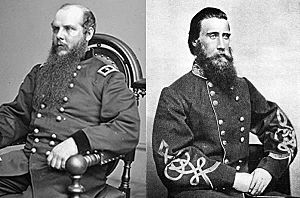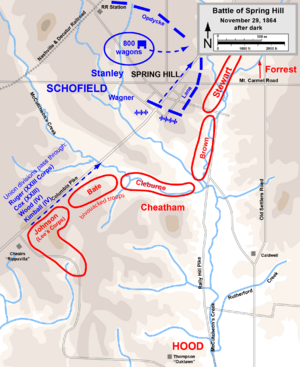Battle of Spring Hill facts for kids
Quick facts for kids Battle of Spring Hill |
|||||||
|---|---|---|---|---|---|---|---|
| Part of the American Civil War | |||||||
 Army commanders Schofield and Hood |
|||||||
|
|||||||
| Belligerents | |||||||
| Commanders and leaders | |||||||
| John M. Schofield | John Bell Hood | ||||||
| Units involved | |||||||
| IV Corps XXIII Corps |
Army of Tennessee | ||||||
| Strength | |||||||
| 7,000 | 12,000 | ||||||
| Casualties and losses | |||||||
| 350 | 500 | ||||||
The Battle of Spring Hill happened on November 29, 1864, in Spring Hill, Tennessee. It was part of the Franklin-Nashville Campaign during the American Civil War. The Confederate Army of Tennessee, led by General John Bell Hood, attacked a Union force. This Union force was commanded by General John M. Schofield. They were retreating from Columbia through Spring Hill.
Because of several mistakes in leadership, the Confederates could not seriously harm the Union soldiers. They also failed to stop the Union army from safely moving north to Franklin during the night. The next day, Hood chased Schofield. He then attacked the Union defenses in the Battle of Franklin. This battle caused many Confederate soldiers to be lost.
Why the Battle Happened
After losing the Atlanta Campaign, General Hood wanted to fight General William T. Sherman. Hood hoped to do this by cutting off Sherman's supply lines. Sherman, however, decided to march from Atlanta to Savannah, Georgia. This famous journey was called Sherman's March to the Sea.
Sherman left forces in Tennessee to stop Hood. These forces were led by General George H. Thomas. They included the IV Corps and the XXIII Corps. General Schofield commanded the XXIII Corps.
Hood moved his army north from Florence between October 30 and November 21. He waited for supplies and for his new cavalry commander, General Nathan Bedford Forrest, to join him. Instead of chasing Sherman, Hood planned a new attack. He decided to move into Tennessee. His goal was to defeat Thomas's army before it could gather all its strength. Then, he wanted to capture Nashville, a key manufacturing city. He even hoped to continue north into Kentucky.
Hood's army marched north from Florence on November 21. General Schofield, leading the Union forces, retreated quickly. He moved north from Pulaski to Columbia. The Union soldiers reached Columbia and built defenses just hours before the Confederates arrived.
From November 24 to 29, there were small fights and artillery attacks around Columbia. This was called the "Battle of Columbia". On November 28, General Thomas told Schofield to prepare to move north to Franklin. Schofield sent his long supply train ahead, guarded by part of the IV Corps. On the same day, Hood sent General Forrest's cavalry divisions east of Columbia. They crossed the river and headed north.
On November 29, Hood sent two of his army corps on a flanking march north. They crossed the Duck River east of Columbia. Two divisions of another corps stayed behind. They fired artillery to make Schofield think a big attack was coming at Columbia. Hood wanted to get his army between Schofield and Thomas. He hoped to defeat Schofield as the Union soldiers retreated north.
Cavalry fights continued all day as the Confederates moved forward. Forrest's cavalry moved wide, forcing the Union cavalry north. This stopped them from interfering with Hood's main army. By 10 a.m. on November 29, Forrest turned his men west toward Spring Hill. The Union cavalry sent many warnings to Schofield. But Schofield did not believe the reports until dawn on November 29. He then realized the danger he was in. He sent General Stanley north with Union troops and artillery. Their job was to protect the supply trains and hold the crossroads at Spring Hill. This would allow the entire Union army to retreat safely to Franklin.
The Battle Begins
Forrest's cavalry reached Spring Hill around 11:30 a.m. They met Union soldiers from the IV Corps. General Stanley had moved quickly north. He set up defenses that protected Spring Hill from three sides. To the northwest, Union lines protected the huge supply trains. Forrest received a message from Hood to hold the position until the main Confederate infantry arrived.
General Patrick R. Cleburne's Confederate division arrived in the afternoon. Forrest's cavalry, running low on ammunition, moved north. They prepared to cover Hood's army or block Schofield's retreat.
Forrest's men moved south. He ordered a brigade to drive off what he thought was a small cavalry force. But they were actually fighting a strong Union brigade. The Union soldiers pushed them back with heavy artillery fire.
A big communication mistake happened when Hood arrived. He set up his headquarters at the Absalom Thompson house. General Cheatham had ordered one of his divisions to attack Spring Hill. But Hood personally ordered that division to move toward the Columbia Pike instead. Neither Hood nor the division commander told Cheatham about this change. The division marched for over two hours. Around 5:30 p.m., they saw a Union column approaching. But before they could fight, an officer from Cheatham's staff arrived. He insisted the division follow Cheatham's original orders.
Back in Columbia, Schofield realized by 3 p.m. that the Confederates would not attack him there. He joined two brigades marching to Spring Hill. He ordered his remaining forces to wait until dark and then join him. As soon as Schofield left, a Confederate general began an attack on the Union position. But he had trouble getting bridges across the river. By the time his troops crossed, the Union forces had already started their withdrawal. The last Union troops left Columbia by 10 p.m.
Cleburne's 3,000 men began an attack around 4 p.m. Their brigades attacked in a staggered line. Hood wanted them to sweep toward the main road and cut off Schofield's arriving units. But he did not seem to know where the Union positions were. The staggered attack was less effective against the Union defenses. Only one Confederate brigade could attack them directly at first. After this brigade asked for help, Cleburne personally led another brigade forward. They attacked the Union right side. These two brigades pushed the Union soldiers back in confusion. The Union soldiers were only stopped by heavy fire from Union artillery.
By this time, another Confederate division had crossed Rutherford Creek. General Cheatham moved them into position for another attack on Spring Hill. This attack was to be on Cleburne's right. As darkness fell, the sound of their guns was supposed to signal Cleburne to attack again. However, this division did not attack. Their commander reported Union troops on his right side and front. He also said that Forrest's cavalry, who were supposed to protect his right, were not there. He decided to talk to his corps commander before moving forward.
Cheatham was trying to find the division that Hood had personally redirected. By the time Cheatham and the division commander talked, it was around 6:15 p.m. It was completely dark. They decided that attacking without knowing what was on their right side could be a disaster. Cheatham rode to Hood's headquarters to talk to the army commander. Hood was very angry that the attack had not happened as he wanted. He was upset that the main road was still open. Cheatham said he needed help from another corps to protect his right side. Hood sent an officer to find that corps commander. Hood was very tired by this time. He had a big dinner and went to bed at 9 p.m. He was sure that his army would fix any problems in the morning and capture Schofield.
Earlier, Hood had brought another corps across Rutherford Creek. He told them to move north of Spring Hill and cut off the Union column. After taking a wrong turn, this corps ended up at Forrest's headquarters. There, they talked about the army's positions. Suddenly, one of Cheatham's officers arrived. He said Hood wanted this corps to support the attack. After going back, the corps commander arrived at the division's command post. But he was confused by the different orders he was getting. So, he went back to Hood's headquarters for clear instructions. He told Hood that his men were tired. It was 11 p.m., and they had been moving since daylight. He had ordered them to rest. Hood accepted this and told the commander to head toward Franklin in the morning after his men had rested.
What Happened Next
The Battle of Spring Hill was a small fight in terms of soldiers lost. About 350 Union soldiers and 500 Confederate soldiers were killed or wounded. But because of bad communication and poor military leadership, all of Schofield's army passed through Spring Hill during the night. The Confederate commanders were sleeping.
Some soldiers noticed the Union army moving north, but no big effort was made to block the road. A Confederate cavalry brigade tried to block the Union supply trains north of Spring Hill. But Union infantry drove them away. A private soldier woke up General Hood at 2 a.m. and reported seeing the Union column moving north. But Hood did nothing except send a message to Cheatham to fire on passing traffic.
By 6:00 a.m. on November 30, all of Schofield's army was far north of Spring Hill. Their lead units had reached Franklin. There, they began to build defenses south of the town. In the morning, Hood discovered Schofield's escape. He was very angry and blamed everyone but himself for the failure. He then ordered his army to chase the Union forces, which led to the terrible Battle of Franklin that afternoon.
Many historians believe Spring Hill was Hood's best chance to trap and defeat the Union army. However, some historians argue that Schofield had other ways to get to Franklin or Nashville. Arguments about who was to blame started quickly. Hood believed Cheatham was most responsible. He also criticized two of Cheatham's division commanders. Hood's official report said that Cheatham was ordered to attack strongly and take the main road. But he made only a weak attack and failed to reach the target. Historians generally agree that both Hood and Cheatham were partly to blame.
Protecting the Battlefield
Parts of the Spring Hill battlefield have changed over time. But most important features are still there. New buildings and roads are quickly covering the historic battlefield. Some land has been protected. This includes land owned by Rippavilla, Inc., the Civil War Preservation Trust (now part of the American Battlefield Trust), and the Tennessee Land Trust. The American Battlefield Trust and its partners have saved a total of 195 acres (0.79 km²) of the battlefield since 1996.




